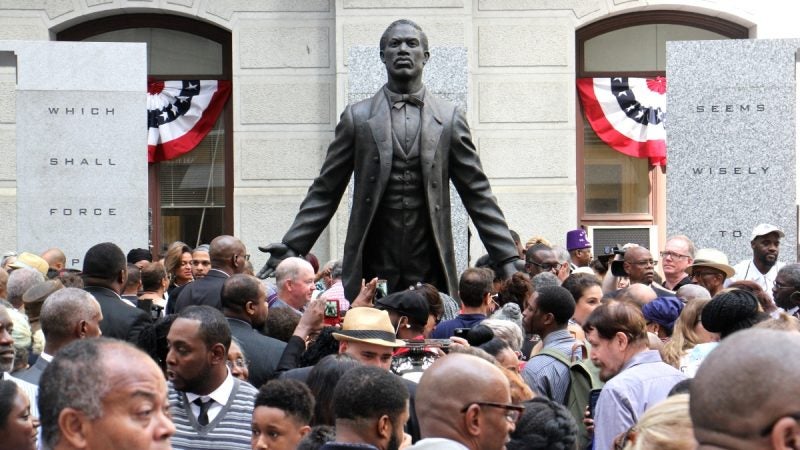Philadelphia’s statues and memorials don’t look like Philadelphia

Mural Arts’ Monument Lab asks the city’s residents: What is an appropriate monument for the current city of Philadelphia? PlanPhilly is publishing some responses from our readership. Want to contribute to the conversation? E-mail Interim Managing Editor Jim Saksa at JSaksa@WHYY.org.
As of 2016, more than 50% of Philadelphia is composed of people of color. African-Americans make up the largest percentage of the city’s minority population at roughly 44%. Despite having a huge minority population, and the fact that most of the city’s elected officials are African-American or people of color, Philadelphia’s monuments and statues are not reflective of Philadelphia’s racial or ethnic views.
Many of Philadelphia’s liberals and people of color know the true history of Christopher Columbus being a failed navigator and corrupt leader who poorly mistreated Natives Americans, but the city has chosen to honor him. Columbus has a memorial and a major boulevard named after him along Penn’s Landing, one of the most frequently visited areas within the city. Another individual Philadelphia has chosen to honor is its former mayor, Frank Rizzo. Located across the street from City Hall, Rizzo’s statue has become a hot button issue in the city since he had a volatile reputation and relationship with the Black and LGBT communities during his time as police commissioner. The Rizzo statue is also in a highly frequented area.
Philadelphia remains “un-woke” concerning the statues in the city. Independence Hall, in another highly frequented area, and is a reminder of this country’s history. Independence Hall and the Liberty Bell represent the founding of this country and the Founding Fathers. However, the history of slavery during this time is largely underrepresented. The President’s House, the original White House, illegally housed nine slaves owned by George Washington (Pennsylvania outlawed slavery in 1780), ironically located a block away from where the Declaration of Independence and U.S. Constitution were signed. In a minority-majority city with a mostly minority controlled city and a liberal voter base, one has to wonder why the statues in the city are not reflective of the transformative city of Philadelphia. There are many other African-Americans who positively impacted Philadelphia – W.E.B. DuBois, Cecil B. Moore, Sadie Tanner Mossell Alexander, Alain Locke – among many others who have not been memorialized like Rizzo or the fictional boxer, Rocky Balboa.
Let’s take a look at a similar city like Washington D.C. The nation’s capital currently has a Black population of 49%. Washington, DC has erected multiple statues to African-Americans and other minorities, including the Martin Luther King, Jr. Memorial, Mary McLeod Bethune Memorial, the Lady Fortitude statue, and the African-American Civil War Memorial among others.
Statues aren’t just simple artistic forms of expression molded with stone or steel. Statues are strategically placed as the focal points of public spaces that carry a direct message. That message from these statues and memorial is internalized over time by each individual if seen enough. Philadelphia could take a page out of Washington’s notebook and carve out spaces for statues that are more inclusive rather than those that drive division like the Frank Rizzo statue has done. The President’s House mentioned the existence of slaves within the memorial but their history is shared without fully acknowledging their contribution to the city at the time where one in six households in Philadelphia had slaves. Philadelphia, to its credit, later became a non-slave state.
It is worth noting that Philadelphia has added two new statues to the city. Hank Willis Thomas’ “All Power to All People”, the giant metal Afro pick located just a few feet away from the Frank Rizzo statue, symbolizes resistance to oppression. The Octavius Catto statue located on the south side of City Hall honors Catto, a Philadelphian civil rights activist. These statues represent more of the inclusivity that Philadelphia portrays itself to be. There is still more work to be done by honoring other marginalized groups in the city. Philadelphia has a rich history of people, movements, and events that truly shaped the city into what it is today. There are some that may argue against the removal or remodeling of statues commemorating those in the past. When you see multiple memorials and statues in highly frequented areas of the sixth largest city in the country, it’s understandable to think those individuals are worthy of utmost praise, but that is only told through a single narrative. As other narratives rise to prominence there is an important question to consider. How can people begin to understand the voices of marginalized groups when the voices and images of their oppressors are held on a pedestal while the voices of marginalized groups are nonexistent or shared with others?
WHYY is your source for fact-based, in-depth journalism and information. As a nonprofit organization, we rely on financial support from readers like you. Please give today.




